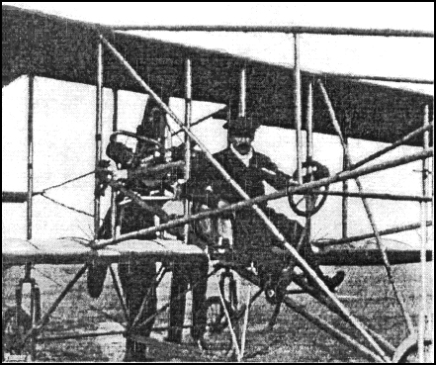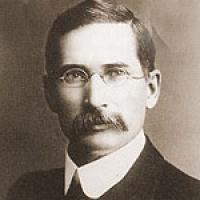Today in Kimberley's History
|
|
|
|
Paterson Aviation Syndicate was registered in Kimberley, 1913
The citizens of Kimberley in the early days of flight went in their thousands to watch the various exhibitions put on for their benefit by Cecil Compton Paterson, Bok Driver and John Weston. Paterson had already made a name for himself by constantly circling the Honoured Dead Memorial. During the Easter holidays of 1912 he made his name in Kimberley by staging “…the most brilliant aviation display ever seen on the diamond fields.” He challenged Arthur Wright to race him on a motor cycle from Alexandersfontein to the Kimberley horse race course (today the semi-industrial area opposite the Diamond Pavilion).
The Diamond Fields Advertiser reported that Compton Paterson won the race easily. Compton-Paterson wrote: “Both machines were made to make a standing start. The motor cycle, however, was given 200 yards start so that its rider would not be inconvenienced by the aeroplane’s movements beforew it took to the air. The plane, however, proved much the faster and covered the course of six miles in something like 6 minutes 45 seconds, beating the motor cycle by over half a mile.” Paterson then went on to give a display of bombing an “enemy” camp with melons and afterwards flew back to Alexandersfontein in the dark. The crowd were suitably impressed. It was shortly after this display that Paterson accomplished the first-ever cross country flight in South Africa, flying from Kimberley to Klerksdorp in four hours and forty two minutes.
A little bit more about the early aviators. Evelyn Frederick (Bok) Driver, Captain Guy Livingstone, and Cecil Compton Paterson, in 1911 formed the African Aviation Syndicate ‘to promote the science and practice of aviation in South Africa’. It had a Paterson biplane and a Bleriot monoplane, and in 1912 acquired another Paterson and Bleriot. Paterson stayed in the air for 35 minutes, reaching a height of 600 metres above sea level on 25 December 1911, a South African record, only to crash the next day. On 27 December 1911 Driver flew the first airmail to Muizenberg from Cape Town, about 13 kilometres away.
The African Aviation Syndicate moved to Kimberley and established a permanent headquarters at Alexandersfontein. Plans were made for the establishment of a flying school, with the tacit approval of Brigadier-General Christiaan Beyers, who was Commandant-General of the Union’s newly formed Defence Force. Disagreement between the principals forced the Syndicate into liquidation in September 1912. A group of Kimberley enthusiasts bought the assets at a public auction in 1912, and Paterson started the Paterson Aviation Syndicate.
A disastrous fire in February 1913 had destroyed all Weston’s aircraft and his workshop, but his dream of the establishment of a flying school for South Africa was about to become a reality. On 1 July 1913, the Paterson Aviation Syndicate was registered in Kimberley. Tom Hill who had purchased the biplane (No 36) that Paterson had continued to operate after the liquidation of the first syndicate, was one of the seven directors of the new syndicate. His co-directors were Ernest Oppenheimer, Alpheus Williams, Herbert Harris, Charles May, David Macgill and George Robertson.
On 10 September 1913 General J.C. Smuts representing the Government of the Union of South Africa, and Cecil Compton Paterson in his personal capacity signed a Memorandum of Agreement whereby the Government agreed to have 10 candidate pilots trained at Alexandersfontein on the outskirst of Kimberley. The trainees included Ken van der Spuy, B.H. Turner, G.S. Creed, G. Clisdal, E.C. Emmett, G.P. Wallace, M.S. Williams, Hopkins, Solomon and M. van Coller. Private pupils included Arthur Turner (not to be confused with B.T. Turner) who was Paterson’s mechanic, and Miss A.M. Bociarelli.
Courtesy of Kimberley Calls...and Recalls Facebook Group
The citizens of Kimberley in the early days of flight went in their thousands to watch the various exhibitions put on for their benefit by Cecil Compton Paterson, Bok Driver and John Weston. Paterson had already made a name for himself by constantly circling the Honoured Dead Memorial. During the Easter holidays of 1912 he made his name in Kimberley by staging “…the most brilliant aviation display ever seen on the diamond fields.” He challenged Arthur Wright to race him on a motor cycle from Alexandersfontein to the Kimberley horse race course (today the semi-industrial area opposite the Diamond Pavilion).
The Diamond Fields Advertiser reported that Compton Paterson won the race easily. Compton-Paterson wrote: “Both machines were made to make a standing start. The motor cycle, however, was given 200 yards start so that its rider would not be inconvenienced by the aeroplane’s movements beforew it took to the air. The plane, however, proved much the faster and covered the course of six miles in something like 6 minutes 45 seconds, beating the motor cycle by over half a mile.” Paterson then went on to give a display of bombing an “enemy” camp with melons and afterwards flew back to Alexandersfontein in the dark. The crowd were suitably impressed. It was shortly after this display that Paterson accomplished the first-ever cross country flight in South Africa, flying from Kimberley to Klerksdorp in four hours and forty two minutes.
A little bit more about the early aviators. Evelyn Frederick (Bok) Driver, Captain Guy Livingstone, and Cecil Compton Paterson, in 1911 formed the African Aviation Syndicate ‘to promote the science and practice of aviation in South Africa’. It had a Paterson biplane and a Bleriot monoplane, and in 1912 acquired another Paterson and Bleriot. Paterson stayed in the air for 35 minutes, reaching a height of 600 metres above sea level on 25 December 1911, a South African record, only to crash the next day. On 27 December 1911 Driver flew the first airmail to Muizenberg from Cape Town, about 13 kilometres away.
The African Aviation Syndicate moved to Kimberley and established a permanent headquarters at Alexandersfontein. Plans were made for the establishment of a flying school, with the tacit approval of Brigadier-General Christiaan Beyers, who was Commandant-General of the Union’s newly formed Defence Force. Disagreement between the principals forced the Syndicate into liquidation in September 1912. A group of Kimberley enthusiasts bought the assets at a public auction in 1912, and Paterson started the Paterson Aviation Syndicate.
A disastrous fire in February 1913 had destroyed all Weston’s aircraft and his workshop, but his dream of the establishment of a flying school for South Africa was about to become a reality. On 1 July 1913, the Paterson Aviation Syndicate was registered in Kimberley. Tom Hill who had purchased the biplane (No 36) that Paterson had continued to operate after the liquidation of the first syndicate, was one of the seven directors of the new syndicate. His co-directors were Ernest Oppenheimer, Alpheus Williams, Herbert Harris, Charles May, David Macgill and George Robertson.
On 10 September 1913 General J.C. Smuts representing the Government of the Union of South Africa, and Cecil Compton Paterson in his personal capacity signed a Memorandum of Agreement whereby the Government agreed to have 10 candidate pilots trained at Alexandersfontein on the outskirst of Kimberley. The trainees included Ken van der Spuy, B.H. Turner, G.S. Creed, G. Clisdal, E.C. Emmett, G.P. Wallace, M.S. Williams, Hopkins, Solomon and M. van Coller. Private pupils included Arthur Turner (not to be confused with B.T. Turner) who was Paterson’s mechanic, and Miss A.M. Bociarelli.
Courtesy of Kimberley Calls...and Recalls Facebook Group
|
Gen. J.B.M. Hertzog founds the Free State National Party - 1914
On 1 July 1914, General James Barry Munnik Hertzog officially established the Free State National Party in Smithfield, Orange Free State. As the National Party was to function on a federal basis, separate branches of the party were founded in the other three provinces of the Union of South Africa shortly afterwards. The party was founded in opposition to the pro-English policy of Prime Minister Louis Botha, who was accused by Hertzog of having "embraced Jingoism". |




